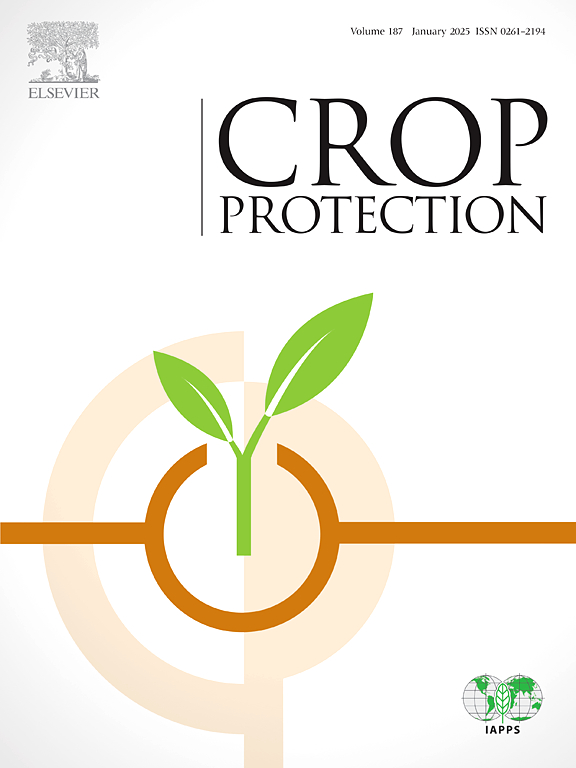贝宁南部辣椒作物(辣椒属)病毒病调查和病毒分子鉴定
IF 2.5
2区 农林科学
Q1 AGRONOMY
引用次数: 0
摘要
促进市场园艺产品的生产是贝宁农业发展的重中之重。辣椒(辣椒属)是一种具有重要经济价值的香料,因其果实而在贝宁各地广泛种植。众所周知,病毒性疾病会对生产造成破坏性影响。本研究旨在确定与贝宁南部辣椒种植相关的病毒。2021 年 9 月,在三个省(大西洋省、滨海省和韦梅省)的五个地区(维达、克波马塞、塞梅、科托努和阿波美-卡拉维)进行了调查和样本采集。对病害发生率和感染严重程度进行了评估。有症状和无症状植株的叶片样本从农民田间随机采集,并通过 RT-PCR 分析病毒,使用 12 对引物对所寻找的不同病毒进行分析。不同地区的总体高发病率在 84.76% 到 100% 之间,平均为 94.46%。至于疾病的严重程度,各地的差异很大,平均为 3.24(塞梅-克波吉)到 2.56(维达-科托努)。通过 RT-PCR 检测各种样本中是否存在病毒所获得的数据分析显示,病毒发生率如下:马铃薯病毒 X(PVX)77.36%、马铃薯病毒 Y 脊髓坏死株(PVYn)52.83%、黄瓜花叶病毒(CMV)47.17%、辣椒叶脉病毒(PeVYV)32.在所调查的五个地区中,黄瓜花叶病毒(CMV)占 52.83%,黄瓜花叶病毒(CMV)占 47.17%,辣椒细脉病毒(PeVYV)占 32.08%,马铃薯黄花叶病毒(PYMV)占 32.08%,多角体病毒(Polerovirus)占 32.08%,Begomovirus 占 32.08%,番茄匙形黄叶病毒(TYLCV)占 18.87%,番茄斑萎病毒(TSWV)占 15.09%,辣椒斑驳病毒(PepMoV)占 11.32%,辣椒轻度斑驳病毒(PMMoV)占 03.77%,PVY 占 0.00%。在样本中搜索的 12 组病毒中,发现了 11 组。每个样本都感染了 12 种病毒中的 1 至 7 种。混合感染在大多数样本中很常见,高发生率表明栽培品种极易受到病毒感染。本文章由计算机程序翻译,如有差异,请以英文原文为准。
Surveys of virus diseases and molecular identification of viruses affecting pepper crops (Capsicum spp.) in southern Benin
Boosting the production of market garden products is a top priority for agricultural development in Benin. Chili pepper (Capsicum spp.), an economically important spice, is widely cultivated for its fruits in different parts of the country. Viral diseases are known to have a devastating impact on production. The objective of this study was to identify the viruses associated with pepper cultivation in southern Benin. Surveys and sample collections were conducted in five districts (Ouidah, Kpomassè, Sèmè, Cotonou, and Abomey-Calavi) from three departments (Atlantic, Littoral, and Ouémè) in September 2021. Disease incidence and severity of infection were assessed. Leaf samples from symptomatic and asymptomatic plants were collected randomly from farmers’ fields and were analyzed for viruses by RT-PCR using twelve primer pairs for different viruses sought. The overall high incidence of diseases varied according to the localities between 84.76% and 100% with an average of 94.46%. As for the severity of the disease, it varied significantly depending on the location of 3.24 (in Sèmè-Kpodji) to 2.56 (in Ouidah Cotonou) on average. The analysis of the data obtained by the detection of the presence of viruses in the various samples by RT-PCR shows the following occurrences: potato virus X (PVX) 77.36%, potato virus Y veinal necrosis strain (PVYn) 52.83%, cucumber mosaic virus (CMV) 47.17%, pepper vein virus (PeVYV) 32.08%, potato yellow mosaic virus (PYMV) 32.08%, Polerovirus 32.08%, Begomovirus 32.08%, tomato spoon yellow leaf (TYLCV) 18.87%, tomato spotted wilt virus (TSWV) 15.09%, pepper mottle virus (PepMoV) 11.32%, pepper mild mottle virus (PMMoV) 03.77%, and PVY 0.00% in the five districts surveyed during the periods under survey. Of the twelve groups of viruses searched for in the samples, eleven were found. Each of the samples is infected with one to seven of the twelve viruses sought. Mixed infections were common in most samples, and the high incidence suggests that the cultivars are highly susceptible to viral infections.
求助全文
通过发布文献求助,成功后即可免费获取论文全文。
去求助
来源期刊

Crop Protection
农林科学-农艺学
CiteScore
6.10
自引率
3.60%
发文量
200
审稿时长
29 days
期刊介绍:
The Editors of Crop Protection especially welcome papers describing an interdisciplinary approach showing how different control strategies can be integrated into practical pest management programs, covering high and low input agricultural systems worldwide. Crop Protection particularly emphasizes the practical aspects of control in the field and for protected crops, and includes work which may lead in the near future to more effective control. The journal does not duplicate the many existing excellent biological science journals, which deal mainly with the more fundamental aspects of plant pathology, applied zoology and weed science. Crop Protection covers all practical aspects of pest, disease and weed control, including the following topics:
-Abiotic damage-
Agronomic control methods-
Assessment of pest and disease damage-
Molecular methods for the detection and assessment of pests and diseases-
Biological control-
Biorational pesticides-
Control of animal pests of world crops-
Control of diseases of crop plants caused by microorganisms-
Control of weeds and integrated management-
Economic considerations-
Effects of plant growth regulators-
Environmental benefits of reduced pesticide use-
Environmental effects of pesticides-
Epidemiology of pests and diseases in relation to control-
GM Crops, and genetic engineering applications-
Importance and control of postharvest crop losses-
Integrated control-
Interrelationships and compatibility among different control strategies-
Invasive species as they relate to implications for crop protection-
Pesticide application methods-
Pest management-
Phytobiomes for pest and disease control-
Resistance management-
Sampling and monitoring schemes for diseases, nematodes, pests and weeds.
 求助内容:
求助内容: 应助结果提醒方式:
应助结果提醒方式:


